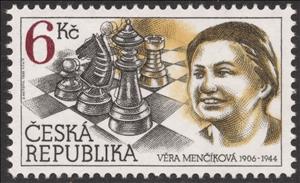Stamp: Czech Chess History: V. Menčíková - Stevensonová (Czech Republic 1996)
Czech Chess History: V. Menčíková - Stevensonová (Czech Republic 1996)
14 February (Czech Republic ) within release Personalities goes into circulation Stamp Czech Chess History: V. Menčíková - Stevensonová face value 6 Czech koruna
| Stamp Czech Chess History: V. Menčíková - Stevensonová in catalogues | |
|---|---|
| Michel: | Mi:CZ 102 |
| POFIS: | POF:CZ 102 |
Stamp is horizontal format.
portrait of V. Mencíková with chess board and piecesStamp Czech Chess History: V. Menčíková - Stevensonová it reflects the thematic directions:
Chess is usually played by two players (called chess players) against each other. It is also possible for one group of chess players to play against another or against one player; such games are often called consultation games. In addition, there is the practice of simultaneous play sessions, when several opponents play against one strong player, each on a separate board.
The rules of the game were basically developed by the 15th century; In modern official tournaments, the rules of the International Chess Federation[6] are applied, which regulate not only the movement of pieces, but also the rights of the judge, the rules of behavior of players and time control. A game played remotely - for example, by correspondence, by telephone or via the Internet - has special rules. There are many variants of chess that differ from classical ones: with non-standard rules, pieces, board sizes, etc. The corresponding section of chess composition is fairy chess. Some aspects of the game of chess are studied in mathematics (for example, the classic “Knight's Move Problem” and “Eight Queens Problem”), including through computer simulation. Chess is usually played by two players (called chess players) against each other. It is also possible for one group of chess players to play against another or against one player; such games are often called consultation games. In addition, there is the practice of simultaneous play sessions, when several opponents play against one strong player, each on a separate board.
The rules of the game were basically developed by the 15th century; In modern official tournaments, the rules of the International Chess Federation[6] are applied, which regulate not only the movement of pieces, but also the rights of the judge, the rules of behavior of players and time control. A game played remotely - for example, by correspondence, by telephone or via the Internet - has special rules. There are many variants of chess that differ from classical ones: with non-standard rules, pieces, board sizes, etc. The corresponding section of chess composition is fairy chess. Some aspects of the game of chess are studied in mathematics (for example, the classic “Knight's Move Problem” and “Eight Queens Problem”), including through computer simulation.

